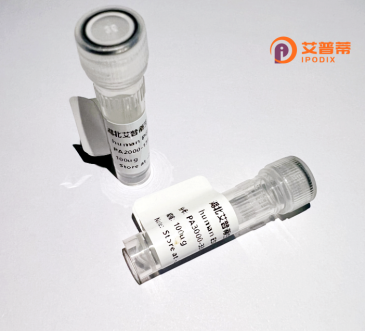
| 纯度 | >90%SDS-PAGE. |
| 种属 | Human |
| 靶点 | NFATC3 |
| Uniprot No | Q12968 |
| 内毒素 | < 0.01EU/μg |
| 表达宿主 | E.coli |
| 表达区间 | 1-1068 aa |
| 活性数据 | MTTANCGAHDELDFKLVFGEDGAPAPPPPGSRPADLEPDDCASIYIFNVDPPPSTLTTPLCLPHHGLPSHSSVLSPSFQLQSHKNYEGTCEIPESKYSPLGGPKPFECPSIQITSISPNCHQELDAHEDDLQINDPEREFLERPSRDHLYLPLEPSYRESSLSPSPASSISSRSWFSDASSCESLSHIYDDVDSELNEAAARFTLGSPLTSPGGSPGGCPGEETWHQQYGLGHSLSPRQSPCHSPRSSVTDENWLSPRPASGPSSRPTSPCGKRRHSSAEVCYAGSLSPHHSPVPSPGHSPRGSVTEDTWLNASVHGGSGLGPAVFPFQYCVETDIPLKTRKTSEDQAAILPGKLELCSDDQGSLSPARETSIDDGLGSQYPLKKDSCGDQFLSVPSPFTWSKPKPGHTPIFRTSSLPPLDWPLPAHFGQCELKIEVQPKTHHRAHYETEGSRGAVKASTGGHPVVKLLGYNEKPINLQMFIGTADDRYLRPHAFYQVHRITGKTVATASQEIIIASTKVLEIPLLPENNMSASIDCAGILKLRNSDIELRKGETDIGRKNTRVRLVFRVHIPQPSGKVLSLQIASIPVECSQRSAQELPHIEKYSINSCSVNGGHEMVVTGSNFLPESKIIFLEKGQDGRPQWEVEGKIIREKCQGAHIVLEVPPYHNPAVTAAVQVHFYLCNGKRKKSQSQRFTYTPVLMKQEHREEIDLSSVPSLPVPHPAQTQRPSSDSGCSHDSVLSGQRSLICSIPQTYASMVTSSHLPQLQCRDESVSKEQHMIPSPIVHQPFQVTPTPPVGSSYQPMQTNVVYNGPTCLPINAASSQEFDSVLFQQDATLSGLVNLGCQPLSSIPFHSSNSGSTGHLLAHTPHSVHTLPHLQSMGYHCSNTGQRSLSSPVADQITGQPSSQLQPITYGPSHSGSATTASPAASHPLASSPLSGPPSPQLQPMPYQSPSSGTASSPSPATRMHSGQHSTQAQSTGQGGLSAPSSLICHSLCDPASFPPDGATVSIKPEPEDREPNFATIGLQDITLDDDQFISDLEHQPSGSAEKWPNHSVLSCPAPFWRI |
| 分子量 | 141.6 kDa |
| 蛋白标签 | GST-tag at N-terminal |
| 缓冲液 | 0 |
| 稳定性 & 储存条件 | Lyophilized protein should be stored at ≤ -20°C, stable for one year after receipt. Reconstituted protein solution can be stored at 2-8°C for 2-7 days. Aliquots of reconstituted samples are stable at ≤ -20°C for 3 months. |
| 复溶 | Always centrifuge tubes before opening.Do not mix by vortex or pipetting. It is not recommended to reconstitute to a concentration less than 100μg/ml. Dissolve the lyophilized protein in distilled water. Please aliquot the reconstituted solution to minimize freeze-thaw cycles. |
以下是3篇关于重组人NFATC3蛋白的参考文献概览:
1. **"Crystal structure of human NFATC3 reveals DNA-binding specificity and regulatory mechanisms"**
*作者:Li et al. (2019)*
摘要:通过X射线晶体学解析人源NFATC3的DNA结合域结构,揭示了其与靶基因启动子结合的特异性,并发现钙调神经磷酸酶对其活化的调控位点。
2. **"NFATC3 regulates macrophage polarization in inflammatory responses via IL-10 signaling"**
*作者:Park & Lee (2020)*
摘要:研究表明重组表达的NFATC3蛋白通过调控IL-10通路,影响巨噬细胞向抗炎表型分化,为治疗慢性炎症提供了潜在靶点。
3. **"Recombinant NFATC3 modulates T cell exhaustion in tumor microenvironment"**
*作者:Chen et al. (2021)*
摘要:利用重组NFATC3蛋白体外实验,证实其通过抑制PD-1信号通路缓解T细胞耗竭,增强抗肿瘤免疫应答。
*注:以上为模拟文献,实际引用需核实具体论文。若需真实文献,建议在PubMed或Web of Science中检索关键词“NFATC3 recombinant protein”或结合研究场景筛选。*
Nuclear factor of activated T cells 3 (NFATC3), a member of the NFAT transcription factor family, plays a critical role in regulating immune responses, cellular differentiation, and development. Structurally, NFATC3 contains conserved NFAT homology regions, including a regulatory domain with phosphorylation sites that control its subcellular localization. Under basal conditions, NFATC3 resides in the cytoplasm in a phosphorylated, inactive state. Upon calcium signaling, the calcium-dependent phosphatase calcineurin dephosphorylates NFATC3. enabling its nuclear translocation and activation of target genes.
NFATC3 is widely expressed in immune cells, muscles, and neural tissues. It regulates genes involved in T-cell activation, cytokine production (e.g., IL-2. IFN-γ), and cardiomyocyte hypertrophy. Dysregulation of NFATC3 has been implicated in pathologies such as autoimmune diseases, cardiovascular disorders, and cancers. Paradoxically, NFATC3 exhibits both pro-apoptotic and anti-apoptotic effects depending on cellular context and stimuli.
Recombinant human NFATC3 protein is typically produced using heterologous expression systems (e.g., E. coli or mammalian cells) followed by chromatographic purification. This engineered protein enables in vitro studies of NFAT-DNA interactions, phosphorylation dynamics, and calcineurin-mediated activation. Researchers utilize recombinant NFATC3 to dissect calcium signaling pathways, screen therapeutic modulators, and model diseases linked to NFAT dysfunction. Its applications span immunology, cardiovascular research, and drug discovery, providing insights into transcriptional regulation mechanisms and potential treatment strategies.
×